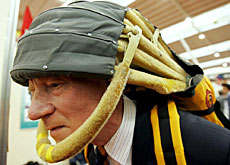Beam me up, Geneva

Star-Trek-style human teleportation may still be years away, but scientists in Geneva have made a key breakthrough in the field of quantum teleportation.
Researchers at Geneva University have developed a “quantum memory”, capturing a single particle of light (a photon) in a crystal and then reproducing and retransmitting it.
The findings, published in last week’s edition of the academic journal Nature, could translate into important applications in the field of quantum cryptography, guaranteeing highly secure communication, and quantum computers that will run billions of times faster than today’s machines.
Quantum teleportation is the transmission of key properties from one particle to another without a physical link. It relies on an aspect of physics known as “entanglement”, whereby the properties of two particles can be tied together even when they are far apart. Albert Einstein called it “spooky action at a distance”.
The Geneva-based team managed to stop a light particle in a tiny one-millimetre crystal cooled to a temperature of minus 270 degrees Celsius.
The photon’s properties were then passed on to some ten million atoms inside the crystal, explained Professor Nicolas Gisin, head of the Group of Applied Physics at Geneva University. He said this produced an echo, like in a cave, re-emitting the photon with the same characteristics.
“We physicists have played with photons for years. It has always been a fascinating challenge to try to stop a photon and hold it for a while – to stop it without destroying it and release it with the same quantum states,” he told swissinfo.
Secure speedy communication
But their research also has a practical application. While their work seems to have little to do with Scotty’s famous teleportation machine, it represents a crucial stage in overcoming the distance problems which affect quantum cryptography today.
The findings will form the basis of a quantum repeater, which will make it possible to develop secure, long-distance quantum communication networks.
Today information is sent via fibre-optic networks as a series of light pulses. A quantum communication system also uses a fibre-optic cable, but a photon’s specific information can be teleported instantaneously.
“The problem with this technology is that the fragile entanglement between two photons is lost over very long distances,” explained Gisin.
After travelling through tens of kilometres of optic fibre, 99 per cent of photons are lost.
Quantum repeaters would tackle this problem by enabling flagging photons to be reactivated, conserving their precious information as they are transmitted, say the scientists.
And the interception of data transmissions encrypted using this technique appears to be impossible – spying on the photons would effectively destroy them.
Commercial applications for quantum cryptography already exist in the banking sector and for secure e-voting. The Geneva firm idQuantique successfully tested a quantum cryptography system for the federal elections in October 2007.
Pure fantasy?
As for the future, Gisin says there is no reason why quantum teleportation should stop at the photon level.
“You could expect to also use molecules,” he said. “However, the theory says and practice confirms that if the object becomes larger and more complex, it becomes more difficult to make a really good high-fidelity teleportation.”
The physicist draws the line at Star Trek’s idea of beaming people or objects to remote planets.
“Science fiction is certainly an inspiration and the word teleportation comes from science fiction. However, in real teleportation, such as in Star Trek, not only is the structure of the object teleported but also the mass. In the view of most physicists this is impossible,” he said.
But Gisin is not totally dismissive of Captain Kirk and Doctor Spock.
“Star Trek is useful and good for science as it allows us to get out of the university and share our enthusiasm for quantum physics,” he commented.
swissinfo, Simon Bradley in Geneva
Quantum teleportation, or entanglement-assisted teleportation, is a technique used to transfer information on a quantum level, usually from one particle (or series of particles) to another particle (or series of particles) in another location via quantum entanglement.
It does not transport energy or matter, nor does it allow communication of information at faster than light speed.
Quantum cryptography, or quantum key distribution, uses quantum mechanics to guarantee secure communication. It enables two parties to produce a shared random-bit string known only to them, which can be used as a key to encrypt and decrypt messages.
An important and unique property of quantum cryptography is the ability of the two communicating users to detect the presence of any third party trying to gain knowledge of the key.

In compliance with the JTI standards
More: SWI swissinfo.ch certified by the Journalism Trust Initiative













You can find an overview of ongoing debates with our journalists here . Please join us!
If you want to start a conversation about a topic raised in this article or want to report factual errors, email us at english@swissinfo.ch.